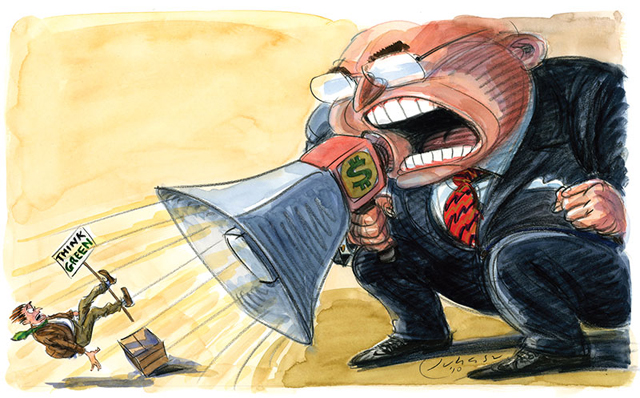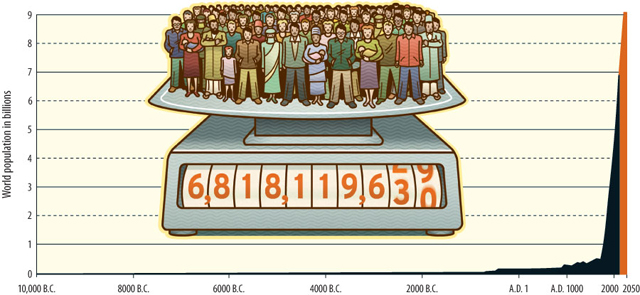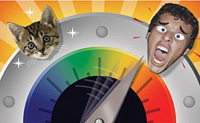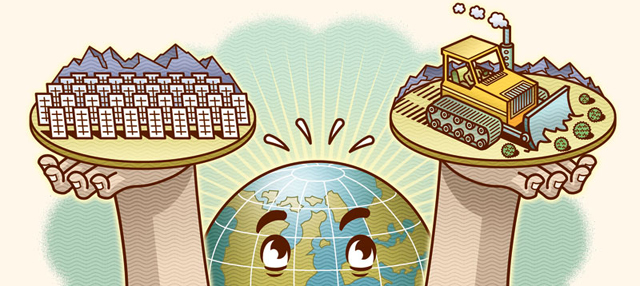sierraclub.org - sierra magazine - may/june 2010 - grapple


Grapple | With Issues and Ideas
A Bigger Boom Box | Up to Speed | Bye-bye aye-aye? | Perspective | Woe Is Us |
As the World Warms |
Holy Shift!
A Bigger Boom Box
The Supreme Court gives corporations vast new powers to influence elections

Decades of efforts to reform U.S. politics by limiting infusions of corporate cash were sent to the landfill in January by the U.S. Supreme Court. The court's 5-4 decision in Citizens United v. FEC freed corporations to spend as much as they want advocating for or against candidates in the crucial closing days of federal elections. The ruling's breadth seemed to spell the end of similar prohibitions on the state and local levels.
How bad will it be for environmental concerns?
"Really bad," says Robert Weissman, president of Public Citizen. "The Supreme Court has just invited Exxon and Chevron and International Paper to spend unlimited amounts of money to affect election outcomes, and there's every reason to believe that they'll accept the invitation."
"It sucks," says Gene Karpinski, president of the League of Conservation Voters. He notes that last year Exxon spent $800,000 to influence elections but $45 million on lobbying. "They can now spend that much directly on elections."
But will they? "The big question is whether they are actually going to use this new tool that has been given to them," says Dave Levinthal, communications director of the Center for Responsive Politics. Corporations already often give to candidates on both sides of the aisle. If they choose sides, he points out, they'd better be sure they pick the winner. And businesses might be leery of aligning with a particular political party, since presumably they'd still welcome customers from both.
One proposed response to the high court's turnaround would require CEOs to personally vouch for their campaign commercials (e.g., "I'm Warren Buffett and I approve this ad"). But corporations could still form front organizations or simply channel their money through existing associations like the U.S. Chamber of Commerce.
Other possible fixes range from relatively easy--an executive order forbidding the government to contract with businesses making campaign expenditures--to dauntingly difficult, like the proposed constitutional amendment to deny for-profit corporations free speech rights. Public financing of elections would also do the trick, Public Citizen's Weissman points out. As to whether a remedy is really necessary, Levinthal notes that it's still early in the 2010 election cycle. "We'll know soon enough," he says. —Paul Rauber
Bye-bye aye-aye?
 Among the few corners of the world where woodpeckers are not found is the island nation of Madagascar. But nature abhors a vacuum, so filling the woodpecker's ecological niche is the aye-aye, the world's largest nocturnal primate. The sole remaining species in its family of lemur, the aye-aye taps on trees and listens intently with its huge, batlike ears. When it detects the echo of a hollow chamber, it gnaws a hole in the wood with its razor-sharp teeth, inserts its strangely elongated middle finger, and extracts a grub for lunch.
Among the few corners of the world where woodpeckers are not found is the island nation of Madagascar. But nature abhors a vacuum, so filling the woodpecker's ecological niche is the aye-aye, the world's largest nocturnal primate. The sole remaining species in its family of lemur, the aye-aye taps on trees and listens intently with its huge, batlike ears. When it detects the echo of a hollow chamber, it gnaws a hole in the wood with its razor-sharp teeth, inserts its strangely elongated middle finger, and extracts a grub for lunch.
In the wake of the March 2009 coup that brought a 35-year-old former DJ to power in Madagascar, aye-ayes and other lemurs are becoming lunch themselves. With a breakdown in the social order, illegal logging is widespread, and smoked lemurs are showing up in local restaurants. Aye-ayes were already at risk, as some Malagasy consider them to be harbingers of doom and kill them on sight. Russ Mittermeier, president of Conservation International (conservation.org) and a lemur expert, points out, however, that "while sparsely distributed, aye-ayes are the most wide-ranging of lemurs." Scarcity may just be their salvation. —P.R.
Perspective

On the scale of human history, things aren't looking so good. Of all the humans who've ever lived, 6.4 percent are alive today. The sheer number of people is overwhelming natural systems, destroying biodiversity, and challenging efforts to control global warming.
Before you jump off the cliff, consider this: Because of the increased availability of family-planning services, fertility is plunging worldwide—from 2.56 children per woman at present to a projected 2.02 in 2050. In sub-Saharan Africa, contraceptive use has doubled since 1995, though only to 12 percent. Another way to look at it: Earth's population is rising at a rate of 80 million people per year—roughly equal to the number of unwanted pregnancies. Solving the population problem means making every child a wanted child. —P.R.
Woe Is Us: Ready, set, panic.
 THE NEW DUST BOWL
THE NEW DUST BOWL
You might think twice about investing in real estate in Arizona. Or Spain. Or South Africa—or northern Africa, for that matter. Because according to grim research from the National Oceanic and Atmospheric Administration (NOAA), those areas and many like them around the globe may soon be locked in an irreversible thousand-year drought.
In the southwestern United States, Lake Mead has already shrunk to 57 percent of capacity because of a long dry spell. (A 2008 study by the Scripps Institution of Oceanography suggested that it might run completely dry by 2021.) Southeast China is turning to groundwater after the worst drought in 60 years. Australia, already the driest inhabited continent, is just emerging from its worst water shortage in history, which prompted an epidemic of suicides among ruined farmers and led Melbourne to engage in a crash program to desalinate seawater. (See "Addicts and Enablers," page 57.) "We are trying to avoid the term 'drought' and saying this is the new reality," water utility director Ross Young told the Melbourne newspaper the Age.
Concentrations of carbon dioxide in the atmosphere now stand at about 384 parts per million. Should that number rise above 450 ppm, according to the NOAA report, "the results would include persistent decreases in dry-season rainfall that are comparable to the 1930s North American Dust Bowl." Deserts would expand; non-irrigated farming in Africa would wither. And ranchettes in the Southwest will be going cheap. —P.R.
AS THE WORLD WARMS
Quick thinking before we slowly fry
SOLAR THROWDOWN Chinese manufacturers are building a great wall around the solar market, beating out U.S. competitors by slashing prices below cost, according to the New York Times. In California, where three-quarters of the nation's solar panels are sold, Chinese companies went from supplying 2 percent of the state's sun-powered megawatts to 46 percent in just three years. U.S. companies aren't entirely losing out, however; eSolar and First Solar have both signed deals to build massive two-gigawatt plants in Inner Mongolia.
TAKE MY MONEY, PLEASE Global investors representing $13 trillion in assets are begging the U.S. Senate to pass a climate bill so they can reap the ensuing bounty of private-sector investment in renewables and energy efficiency. The 450 global investors who gathered in New York earlier this year for the Investor Summit on Climate Risk believe that there's big money to be made in clean energy—but only if the government puts a price on carbon.
IDLE SPECULATION Long-haul trucks spend about six hours a day idling, in part because drivers need the engine to warm or cool the cab while they catch up on sleep. All that running in place accounts for 11 million tons of carbon dioxide each year. Spurred by anti-idling legislation, trucking companies are starting to equip their rigs with battery-powered air conditioners, bunk heaters, and auxiliary power units. The federal government is also spending $22 million to electrify 50 truck stops, so resting drivers can power up from the grid instead of the engine. —Dashka Slater

ON THE ONE HAND . . .
With its ample sunshine and wide-open spaces, the Mojave Desert is fast becoming a hotbed for concentrated solar plants, which many see as renewable energy's best hope for maxing out megawatts. The idea, which dates back to Archimedes, is that mirrors focus the sun's rays to produce heat. That spins turbines to generate electricity. Some 52 solar-power-plant projects are in the works in California alone, which could produce up to 39,000 megawatts.
ON THE OTHER . . .
Preparing a tract of desert for concentrated solar-power production means flattening it out and removing all traces of vegetation. Given that each facility requires 5 to 14 acres per megawatt produced and that a single plant covers 2 to 20 square miles, it's no small impact. California senator Dianne Feinstein has introduced legislation that would make a million Mojave Desert acres off-limits to solar and wind development, arguing that the 19 projects proposed for the area are inappropriate for land that was donated to the government for preservation. —D.S.
Holy Shift!
Manual transmissions help good drivers boost their MPG
Driven a stick shift lately? Probably not. While 29 percent of passenger vehicles had manual transmissions in 1987, only 7 percent did in 2008. That's a pity, because even in the era of computer-controlled automatics, manual transmissions still tend to provide more miles per gallon of gas.
You wouldn't know that from the window stickers on new cars, though. Nine of 2009's top-10 best-selling models were available in manual-transmission versions, which the EPA claims get only 1.5 percent better mileage than their automatic counterparts. Yet an analysis of the results reported to the EPA by real-world drivers of those same cars shows the manuals with a 12.1 percent mpg lead over the automatics. And in a 2008 test of seven small cars, Consumer Reports found manual models to be 12.5 percent more efficient than their automatic counterparts, while the EPA reported only a 3.2 percent difference in a test of the same cars.
To test fuel economy, the EPA uses a dynamometer, a treadmill-like device that runs vehicles through routines designed to emulate real-world driving. Manuals and automatics are tested using the same routines, but for manuals, automakers indicate exactly when shifting should take place.
So why do real-world stick users get better mileage than EPA testers? The difference could be that between a dynamometer and city streets. Even Linc Wehrly, manager of the EPA's Light-Duty Vehicle Group, admits that the agency's test doesn't accurately reflect patterns peculiar to manual drivers—coasting up to stoplights, for example. Drivers can anticipate speed changes and respond to traffic flow, managing the engine more efficiently than with an automatic transmission or a predetermined shift schedule. Improving fuel economy can be as simple as putting the driver in charge.
—Jeremy Jackson
Photos and illustrations, from top: Victor Juhasz; Pete Oxford/Minden Pictures/National Geographic Stock; Peter and Maria Hoey (2)